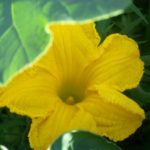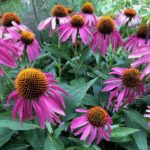Full Moon Greetings – September 29, 2023
Corn’s Quirky Nature
You might not think much about corn (Zea mays or Maize) in your garden or on your plate, but it has fascinating and distinct characteristics from most other plants you grow.
First of all, corn is a grain. (The grain family includes plants like wheat, rye, and barley.) But unlike other grains, the seeds (kernels) are wrapped in a tight husk that prevents them from dispersing. Another difference between corn and other grains is that the kernels are much larger, which is why we often think of corn as a vegetable.
No Bees Needed for Pollination
 Most other garden plants need bees or other insects for pollination – not so for corn. It depends on the wind for pollination. Tassels at the top of the plant release pollen when a breeze moves them. Pollen then reaches the corn silks emerging from the stalks and pollination takes place. Each strand of silk is connected to a kernel below. If you open an ear of corn and see that some kernels are missing it means they did not get pollinated. Wind pollination is a reason that corn should ideally be planted in blocks rather than rows to ensure more opportunity for pollen to reach silk.
Most other garden plants need bees or other insects for pollination – not so for corn. It depends on the wind for pollination. Tassels at the top of the plant release pollen when a breeze moves them. Pollen then reaches the corn silks emerging from the stalks and pollination takes place. Each strand of silk is connected to a kernel below. If you open an ear of corn and see that some kernels are missing it means they did not get pollinated. Wind pollination is a reason that corn should ideally be planted in blocks rather than rows to ensure more opportunity for pollen to reach silk.
Humans are Needed
Corn – the plant we know – does not exist in the wild. It was first domesticated over 10,000 years ago in what is now southern Mexico. The grain that corn originated from, teosinte, still grows wild in parts of Mexico and Central America. Our modern corn looks significantly different than its ancestor teosinte. (You can see a comparison at Wikimedia Commons.)
 As humans began to select the traits they wanted in the plant (including kernels that were larger and also stayed put instead of scattering) the plant lost its ability to exist on its own. It is dependent on human cultivation. The tight husk around the corn cob prevents the seeds from propagating as a wild plant would. They can’t fall to the ground or be scattered by the wind or birds.
As humans began to select the traits they wanted in the plant (including kernels that were larger and also stayed put instead of scattering) the plant lost its ability to exist on its own. It is dependent on human cultivation. The tight husk around the corn cob prevents the seeds from propagating as a wild plant would. They can’t fall to the ground or be scattered by the wind or birds.
My Three Sisters Experiment
Corn has been an important part of many Native American cultures for centuries. They planted it together with beans and pumpkins to create a companion plant family called the Three Sisters. Each plant can provide benefits to the other two. Beans bring nitrogen to the soil for both of the other plants. The corn provides a place for the beans to climb and protection from too much sun for the  pumpkins. And pumpkins provide a living mulch for the other plants.
pumpkins. And pumpkins provide a living mulch for the other plants.
As reported in an earlier blog, I attempted to create a Three Sister’s bed this spring, but my results were a little imperfect. The corn was prolific and beautiful. And the beans did fine, but my pumpkins, which are usually pretty abundant, didn’t do so well nestled amongst the corn.
Even though I didn’t get exactly the results I had hoped for, there were many positives. Zea mays is an impressive and majestic addition to the garden. And of course – we had fresh corn to eat, which was lovely. Just reading and learning more about this plant, which I don’t often grow, was fun and fascinating.
Mindful Reminders from Corn
One of the joys of gardening is trying out new things which I think of as conducting garden experiments. Like life, sometimes things pan out the way we hoped and sometimes they don’t. When they don’t, we can make changes moving forward. Next season, I will plant two sisters together – corn and beans, and my pumpkins will be back in their own garden bed.
 Corn also reminds us of the uniqueness of all plants and the long-intertwined history that humans have with this and other crops. Taking the time to tune in, pay attention, and learn more about distinct plants like Zia mays helps us appreciate the amazing planet that we live on.
Corn also reminds us of the uniqueness of all plants and the long-intertwined history that humans have with this and other crops. Taking the time to tune in, pay attention, and learn more about distinct plants like Zia mays helps us appreciate the amazing planet that we live on.
And lastly, as autumn turns my corn stalks into dried sentries of their former selves, they are still providing gifts. In the slightest breeze, there is gentle rustling music from the stalks – a reminder that beauty can be found in different seasons and in different ways.
Lunar Blog Post Series

This post is part of my lunar blog series. Each full moon I write about one plant, many of them are plants featured in my book, Growing Mindful. Each new moon I write about a topic related to gardens, mindfulness, and spirituality. For more details and a list of past lunar blog posts, click here.





Hello Joan, there is so much music in the garden this time of year! Happy harvest moon to you. Enjoy the music.
Thanks Susan!I hope you are enjoying the season as well.